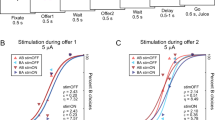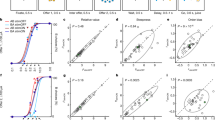Abstract
Disappointment entails the recognition that one did not get the value expected. In contrast, regret entails recognition that an alternative (counterfactual) action would have produced a more valued outcome. In humans, the orbitofrontal cortex is active during expressions of regret, and humans with damage to the orbitofrontal cortex do not express regret. In rats and nonhuman primates, both the orbitofrontal cortex and the ventral striatum have been implicated in reward computations. We recorded neural ensembles from orbitofrontal cortex and ventral striatum in rats encountering wait or skip choices for delayed delivery of different flavors using an economic framework. Economically, encountering a high-cost choice after skipping a low-cost choice should induce regret. In these situations, rats looked backwards toward the lost option, cells within orbitofrontal cortex and ventral striatum represented the missed action, rats were more likely to wait for the long delay, and rats rushed through eating the food after that delay.
This is a preview of subscription content, access via your institution
Access options
Subscribe to this journal
Receive 12 print issues and online access
$209.00 per year
only $17.42 per issue
Buy this article
- Purchase on Springer Link
- Instant access to full article PDF
Prices may be subject to local taxes which are calculated during checkout








Similar content being viewed by others
References
Coricelli, G., Dolan, R.J. & Sirigu, A. Brain, emotion and decision making: the paradigmatic example of regret. Trends Cogn. Sci. 11, 258–265 (2007).
Camille, N. et al. The involvement of the orbitofrontal cortex in the experience of regret. Science 304, 1167–1170 (2004).
Gilovich, T. & Medvec, V.H. The experience of regret: what, when, and why. Psychol. Rev. 102, 379–395 (1995).
Bell, D. Regret in decision making under uncertainty. Oper. Res. 30, 961–981 (1982).
Landman, J. & Manis, J.D. What might have been: counterfactual thought concerning personal decisions. Br. J. Psychol. 83, 473–477 (1992).
Loomes, G. & Sugden, R. Regret theory: an alternative theory of rational choice under uncertainty. Econ. J. 92, 805–824 (1982).
Loomes, G. & Sugden, R. Disappointment and dynamic consistency in choice under uncertainty. Rev. Econ. Stud. 53, 271–282 (1986).
Bell, D. Disappointment in decision making under uncertainty. Oper. Res. 33, 1–27 (1985).
Landman, J. Regret: a theoretical and conceptual analysis. J. Theory Soc. Behav. 17, 135–160 (1987).
Lee, D. Neural basis of quasi-rational decision making. Curr. Opin. Neurobiol. 16, 191–198 (2006).
Coricelli, G. et al. Regret and its avoidance: a neuroimaging study of choice behavior. Nat. Neurosci. 8, 1255–1262 (2005).
Schoenbaum, G., Chiba, A.A. & Gallagher, M. Orbitofrontal cortex and basolateral amygdala encode expected outcomes during learning. Nat. Neurosci. 1, 155–159 (1998).
Tremblay, L. & Schultz, W. Relative reward preference in primate orbitofrontal cortex. Nature 398, 704–708 (1999).
Padoa-Schioppa, C. & Assad, J.A. Neurons in the orbitofrontal cortex encode economic value. Nature 441, 223–226 (2006).
Jones, J.L. et al. Orbitofrontal cortex supports behavior and learning using inferred but not cached values. Science 338, 953–956 (2012).
Takahashi, Y.K. et al. Neural estimates of imagined outcomes in the orbitofrontal cortex drive behavior and learning. Neuron 80, 507–518 (2013).
Wilson, R.C., Takahashi, Y.K., Schoenbaum, G. & Niv, Y. Orbitofrontal cortex as a cognitive map of task space. Neuron 81, 267–279 (2014).
Sul, J.H., Kim, H., Huh, N., Lee, D. & Jung, M.W. Distinct roles of rodent orbitofrontal and medial prefrontal cortex in decision making. Neuron 66, 449–460 (2010).
Abe, H. & Lee, D. Distributed coding of actual and hypothetical outcomes in the orbital and dorsolateral prefrontal cortex. Neuron 70, 731–741 (2011).
Schoenbaum, G., Nugent, L.S., Saddoris, M.P. & Setlow, B. Orbitofrontal lesions in rats impair reversal but not acquisition of go, no-go odor discriminations. Neuroreport 13, 885–890 (2002).
Fellows, L.K. & Farah, M.J. Ventromedial frontal cortex mediates affective shifting in humans: evidence from a reversal learning paradigm. Brain 126, 1830–1837 (2003).
Rudebeck, P.H., Saunders, R.C., Prescott, A.T., Chau, L.S. & Murray, E.A. Prefrontal mechanisms of behavioral flexibility, emotion regulation and value updating. Nat. Neurosci. 16, 1140–1145 (2013).
McDannald, M.A., Lucantonio, F., Burke, K.A., Niv, Y. & Schoenbaum, G. Ventral striatum and orbitofrontal cortex are both required for model-based, but not model-free, reinforcement learning. J. Neurosci. 31, 2700–2705 (2011).
McDannald, M.A. et al. Model-based learning and the contribution of the orbitofrontal cortex to the model-free world. Eur. J. Neurosci. 35, 991–996 (2012).
Steiner, A.P. & Redish, A.D. The road not taken: neural correlates of decision making in orbitofrontal cortex. Front. Neurosci. 6, 131 (2012).
Cromwell, H.C. & Schultz, W. Effects of expectations for different reward magnitudes on neuronal activity in primate striatum. J. Neurophysiol. 89, 2823–2838 (2003).
O'Doherty, J. et al. Dissociable roles of ventral and dorsal striatum in instrumental conditioning. Science 304, 452–454 (2004).
Roesch, M.R., Singh, T., Brown, P.L., Mullins, S.E. & Schoenbaum, G. Ventral striatal neurons encode the value of the chosen action in rats deciding between differently delayed or sized rewards. J. Neurosci. 29, 13365–13376 (2009).
van der Meer, M.A. & Redish, A. Covert expectation-of-reward in rat ventral striatum at decision points. Front. Integr. Neurosci 3, 1–15 (2009).
Lavoie, A.M. & Mizumori, S.J. Spatial, movement- and reward-sensitive discharge by medial ventral striatum neurons of rats. Brain Res. 638, 157–168 (1994).
Setlow, B., Schoenbaum, G. & Gallagher, M. Neural encoding in ventral striatum during olfactory discrimination learning. Neuron 38, 625–636 (2003).
Takahashi, Y.K. et al. The orbitofrontal cortex and ventral tegmental area are necessary for learning from unexpected outcomes. Neuron 62, 269–280 (2009).
Takahashi, Y.K. et al. Expectancy-related changes in firing of dopamine neurons depend on orbitofrontal cortex. Nat. Neurosci. 14, 1590–1597 (2011).
Schoenbaum, G. & Eichenbaum, H. Information coding in the rodent prefrontal cortex. I. Single-neuron activity in orbitofrontal cortex compared with that in pyriform cortex. J. Neurophysiol. 74, 733–750 (1995).
Roitman, M.F., Wheeler, R.A. & Carelli, R.M. Nucleus accumbens neurons are innately tuned for rewarding and aversive taste stimuli, encode their predictors, and are linked to motor output. Neuron 45, 587–597 (2005).
Landman, J. Regret: The Persistence of the Possible (Oxford Univ. Press, 1993).
Connolly, T. & Butler, D. Regret in economic and psychological theories of choice. J. Behav. Decis. Mak. 19, 139–154 (2006).
Aronson, E. The effect of effort on the attractiveness of rewarded and unrewarded stimuli. J. Abnorm. Soc. Psychol. 63, 375–380 (1961).
Arkes, H.R. & Ayton, P. The sunk cost and Concorde effects: are humans less rational than lower animals? Psychol. Bull. 125, 591 (1999).
Hare, T.A., Camerer, C.F. & Rangel, A. Self-control in decision-making involves modulation of the vmPFC valuation system. Science 324, 646–648 (2009).
Krajbich, I., Armel, C. & Rangel, A. Visual fixations and the computation and comparison of value in simple choice. Nat. Neurosci. 13, 1292–1298 (2010).
Bray, S., Shimojo, S. & O'Doherty, J.P. Human medial orbitofrontal cortex is recruited during experience of imagined and real rewards. J. Neurophysiol. 103, 2506–2512 (2010).
Walton, M.E., Behrens, T.E., Buckley, M.J., Rudebeck, P.H. & Rushworth, M.F. Separable learning systems in the macaque brain and the role of orbitofrontal cortex in contingent learning. Neuron 65, 927–939 (2010).
Noonan, M.P. et al. Separate value comparison and learning mechanisms in macaque medial and lateral orbitofrontal cortex. Proc. Natl. Acad. Sci. USA 107, 20547–20552 (2010).
Rushworth, M.F., Noonan, M.P., Boorman, E.D., Walton, M.E. & Behrens, T.E. Frontal cortex and reward-guided learning and decision-making. Neuron 70, 1054–1069 (2011).
Carmichael, S.T. & Price, J.L. Limbic connections of the orbital and medial prefrontal cortex in macaque monkeys. J. Comp. Neurol. 363, 615–641 (1995).
Carmichael, S.T. & Price, J.L. Sensory and premotor connections of the orbital and medial prefrontal cortex of macaque monkeys. J. Comp. Neurol. 363, 642–664 (1995).
Ongür, D. & Price, J.L. The organization of networks within the orbital and medial prefrontal cortex of rats, monkeys and humans. Cereb. Cortex 10, 206–219 (2000).
Schilman, E.A., Uylings, H.B., Galis-de Graaf, Y., Joel, D. & Groenewegen, H.J. The orbital cortex in rats topographically projects to central parts of the caudate-putamen complex. Neurosci. Lett. 432, 40–45 (2008).
Mailly, P., Aliane, V., Groenewegen, H.J., Haber, S.N. & Deniau, J.M. The rat prefrontostriatal system analyzed in 3D: evidence for multiple interacting functional units. J. Neurosci. 33, 5718–5727 (2013).
Janabi-Sharifi, F., Hayward, V. & Chen, C.S.J. Discrete-time adaptive windowing for velocity estimation. IEEE Trans. Control Syst. Technol. 8, 1003–1009 (2000).
Hart, W.E., Goldbaum, M., Cote, B., Kube, P. & Nelson, M.R. Measurement and classification of retinal vascular tortuosity. Int. J. Med. Inform. 53, 239–252 (1999).
Zhang, K., Ginzburg, I., McNaughton, B.L. & Sejnowski, T.J. Interpreting neuronal population activity by reconstruction: unified framework with application to hippocampal place cells. J. Neurophysiol. 79, 1017–1044 (1998).
Acknowledgements
We thank C. Boldt and K. Seeland for technical support and other members of the Redish laboratory for discussion. This work was supported by US National Institutes of Health grants T32 NS048944 (A.P.S.), T32 DA007234 (A.P.S.) and R01-DA030672 (A.D.R.).
Author information
Authors and Affiliations
Contributions
A.P.S. and A.D.R. conducted the experiments, collected the data, performed the analysis and wrote the manuscript.
Corresponding author
Ethics declarations
Competing interests
The authors declare no competing financial interests.
Supplementary information
Supplementary Text and Figures
Supplementary Figures 1–17 and Supplementary Tables 1 and 2 (PDF 24838 kb)
Rights and permissions
About this article
Cite this article
Steiner, A., Redish, A. Behavioral and neurophysiological correlates of regret in rat decision-making on a neuroeconomic task. Nat Neurosci 17, 995–1002 (2014). https://doi.org/10.1038/nn.3740
Received:
Accepted:
Published:
Issue Date:
DOI: https://doi.org/10.1038/nn.3740
This article is cited by
-
Increased cortical structural covariance correlates with anhedonia in schizophrenia
Schizophrenia (2023)
-
Distinct value computations support rapid sequential decisions
Nature Communications (2023)
-
Attributing Psychological Predicates to Non-human Animals: Literalism and its Limits
Review of Philosophy and Psychology (2023)
-
Taking stock of value in the orbitofrontal cortex
Nature Reviews Neuroscience (2022)
-
Sunk cost sensitivity during change-of-mind decisions is informed by both the spent and remaining costs
Communications Biology (2022)



